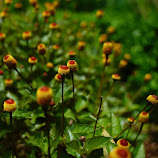This intriguing characteristic has earned it the nickname “electric daisy” and has made it a staple in both traditional medicine and contemporary culinary practices.
A Botanical Overview
Spilanthes acmella, the electric daisy, is a small,
flowering plant that belongs to the Asteraceae family, which also includes
daisies, sunflowers, and marigolds. The plant typically grows to a height of
about 12 to 15 inches and produces small, yellow, and red flowers that resemble
miniature pom-poms or eyeballs—hence the colloquial name "toothache
plant."
The active compound responsible for the electric sensation
is spilanthol, a bioactive alkylamide that has been studied for its various
pharmacological properties. Spilanthol is found in the leaves, stems, and
particularly in the flower heads of the plant. When consumed, spilanthol
interacts with the trigeminal nerve endings in the mouth, causing a tingling,
numbing, or even slightly burning sensation, similar to a mild electric
shock—hence the “electric” in electric daisy.
Traditional Uses And Medicinal Benefits
The herb is believed to enhance the body’s natural defense mechanisms, helping to ward off infections. It is also used to treat conditions such as gum diseases, mouth infections, and even to promote digestion. The plant’s anti-inflammatory properties make it a popular remedy for joint pain and arthritis as well.Beyond its anesthetic uses, spilanthol is also known to have diuretic, antipyretic (fever-reducing), and aphrodisiac properties. In some cultures, the plant is used to treat conditions like malaria and scurvy, though these uses are less common in contemporary herbal practices.
Culinary And Cosmetic Applications
In addition to its medicinal uses, the electric daisy has
found a place in the culinary world, particularly in the cuisine of Brazil and
Southeast Asia. The leaves and flowers are often used to add a unique, spicy,
and tingling feeling to dishes. In Brazilian cuisine, jambu is a key ingredient
in certain traditional dishes like tacacá, a popular soup made with jambu,
tucupi (fermented manioc juice), and shrimp. The numbing effect of the herb
adds a distinctive sensory experience that is both novel and enjoyable.
The electric daisy has also gained popularity in modern
gastronomy, especially in the world of molecular cuisine. Chefs use the herb to
create innovative dishes and cocktails that play with the contrast of flavors
and sensations. The tingling sensation provided by the electric daisy can be an
exciting addition to a variety of culinary creations, from appetizers to
desserts.
In the cosmetic industry, spilanthol is valued for its
ability to relax facial muscles, making it a natural alternative to Botox.
Products containing extracts from the electric daisy are marketed as naturalanti-aging solutions that reduce the appearance of fine lines and wrinkles. The
herb’s anti-inflammatory and antimicrobial properties also make it a beneficial
ingredient in skincare formulations, particularly for acne-prone skin.
Scientific Studies And Modern Research
Modern science has begun to validate many of the traditional uses of the electric daisy. Research has shown that spilanthol possesses significant anesthetic properties, which explain its efficiency in treating toothaches and other oral discomforts. Studies have also demonstrated the herb’s potential as an anti-inflammatory agent, supporting its use in treating conditions like arthritis.Further research into spilanthol has revealed its potential as an insecticide, offering a natural alternative to chemical pesticides.
This is particularly relevant in regions where mosquito-borne diseases are prevalent. Additionally, the herb’s immune-boosting properties have been studied, with some evidence suggesting that it may enhance the body’s ability to fight off infections.Despite these promising findings, much of the research on the electric daisy is still in its early stages. While traditional uses provide a wealth of anecdotal evidence, more clinical trials and studies are needed to fully understand the herb’s potential benefits and any possible side effects.
Cultivation And Sustainability
The electric daisy is a relatively easy plant to grow,
thriving in warm, tropical climates with plenty of sunlight and well-drained
soil. It can be grown from seeds or cuttings, and with proper care, it can
yield a bountiful harvest of leaves and flowers. In regions where the climate
is cooler, the plant can be grown indoors or in greenhouses, making it
accessible to herbalists and gardeners around the world.
Sustainability is an important thought in the cultivation of
the electric daisy, especially as demand for the herb increases. Overharvesting
in the wild can lead to depletion of natural populations, so cultivating the
plant in controlled environments is crucial to ensuring its availability for
future generations.
Conclusion
The electric daisy is more than just a plant with a peculiar
name and a unique sensation. It is a herb with a rich history, a wide range of
medicinal benefits, and exciting applications in both the culinary and cosmetic
industries. As modern science continues to explore its potential, the electric
daisy stands as a witness to the enduring value of traditional knowledge and
the natural world’s ability to inspire and heal. Whether used to soothe a
toothache, spice up a dish, or reduce wrinkles, the electric daisy offers a
touch of nature’s magic in every bite or application.
.jfif)


.jpeg)

.jpeg)
No comments:
Post a Comment